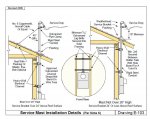Pascal2
Member
- Location
- Chicago, Illinois
NEC is not very helpful:
225.17 Masts as Supports (A) Strength. The mast shall have adequate strength or be supported by braces or guys to safely withstand the strain imposed by the overhead feeder or branch-circuit conductors.
Is there some convention to calculate the required size for a mast? I'd like to find a general calculator or table or something, but in the current case I need a mast for a 25' span of 6 AWG quadruplex to a 9' tall detached residential garage with a nearly flat roof. 225.18(2) requires 12' clearance above grade so I'll probably extend the mast 4' above the roof with a weather head on top and cable attachment at 3.5'. Based solely on conduit fill, it appears I only need 3/4" conduit. The cable itself only weighs 0.162 lbs per ft, so 4 lb total, plus hardware, but this is Colorado so ice and wind load are not insignificant.
225.17 Masts as Supports (A) Strength. The mast shall have adequate strength or be supported by braces or guys to safely withstand the strain imposed by the overhead feeder or branch-circuit conductors.
Is there some convention to calculate the required size for a mast? I'd like to find a general calculator or table or something, but in the current case I need a mast for a 25' span of 6 AWG quadruplex to a 9' tall detached residential garage with a nearly flat roof. 225.18(2) requires 12' clearance above grade so I'll probably extend the mast 4' above the roof with a weather head on top and cable attachment at 3.5'. Based solely on conduit fill, it appears I only need 3/4" conduit. The cable itself only weighs 0.162 lbs per ft, so 4 lb total, plus hardware, but this is Colorado so ice and wind load are not insignificant.


